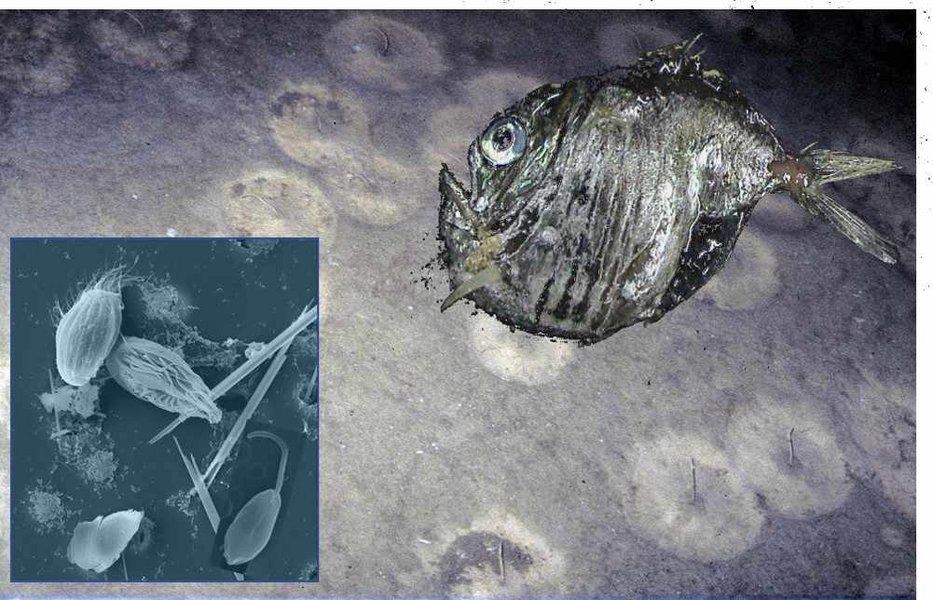Apr 28 2021
A new study compared 20 deep-sea basins in the Atlantic and Pacific Oceans, demonstrating for the first time the extremely high and also highly specific species diversity of the deep sea.
 The deep-sea has an enormous diversity of species. Among the organisms, unicellular organisms such as bacterivorous and parasitic flagellates and ciliates dominate. Image Credit: Hartmut Arndt.
The deep-sea has an enormous diversity of species. Among the organisms, unicellular organisms such as bacterivorous and parasitic flagellates and ciliates dominate. Image Credit: Hartmut Arndt.
The study was performed by ecologists from the Institute of Zoology of the University of Cologne. Across two decades, a team of researchers under Professor Dr Hartmut Arndt from the Institute of Zoology has put together a wealth of data that, for the first time, enables a comparison of the diversity of existing eukaryotes, or organisms with a cell nucleus.
A complete picture of biodiversity in the deep sea has been offered by sediment samples collected from depths of 4000–8350 m, the cultivation and sequencing of populations that occur mainly in the deep sea, and lastly, molecular analysis with high-throughput methods.
The findings of the study have been reported in the Communications Biology journal in an article titled “High and specific diversity of protists in the deep-sea basins dominated by diplonemids, kinetoplastids, ciliates and foraminiferans.”
More than 60% of the Earth’s surface is covered by the deep-sea floor with water depths of over 1000 m covers. This makes the deep-sea floor the largest part of the biosphere. However, not much is known about the distribution patterns, diversity, and functional significance of organisms in this enormous and extreme habitat.
One thing is certain: climate change—for instance by oxygen depletion, warming, or acidification—is already affecting this sensitive ecosystem. Besides, the ever-increasing interest in raw material extraction has placed the deep sea under pressure.
Earlier, researchers presumed that deep-sea basins—characterized by the same salinity (about 3.6%), low temperature (0 °C to 4 °C), very similar sediment, and high pressure (300 to 500 bar based on the depth)—feature comparatively low, as well as the same, species diversity.
A majority of the deep-sea investigations so far have also focused on particular habitats like saltwater lenses and hydrothermal vents. To date, data related to the diversity of deep-sea plains, constituting indubitably the largest portion of the seafloor, has been lacking.
By using a new approach of combined molecular biology and cultivation-based studies, we found substantial, highly specific local differences in organism communities with little overlap to the organism communities of coastal regions.
Dr Alexandra Schönle, Study Lead Author, Institute of Zoology, University of Cologne
Unicellular organisms, or protists that have been largely ignored in existing deep-sea food web models, dominated among all the life forms.
Apart from the calcareous chambered organisms (foraminifera) conventionally analyzed in studies, the deposits of which dominate enormous areas of the oceans across the world, small naked protists dominated. These include parasitic, bacterivorous flagellates and ciliates, whose diversity considerably exceeded that of multicellular animals.
The high proportion of parasitic forms of 10% to 20%, which was earlier unknown on this scale, was also astonishing. Several of them could possibly infect animals like fish or crustaceans, while others could possibly infect protozoa.
Our results show that organic matter on the deep-sea floor is recycled through different and previously insufficiently considered components of the microbial food web, and then passed on in the food web. This is crucial for our understanding of global carbon flux.
Dr Hartmut Arndt, Professor, Institute of Zoology, University of Cologne
“Given the significant differences in the biodiversity of the individual deep-sea basins and their importance in the global context, the economic exploitation and foreseeable devastation of individual deep-sea basins and the sparing of other deep-sea basins seems absurd,” Dr Arndt concluded.
Journal Reference:
Schönle, A., et al. (2021) High and specific diversity of protists in the deep-sea basins dominated by diplonemids, kinetoplastids, ciliates and foraminiferans. Communications Biology. doi.org/10.1038/s42003-021-02012-5.